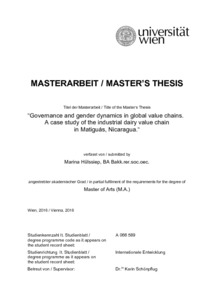Governance and gender dynamics in global value chains: A case study of the industrial dairy value chain in Matiguás, Nicaragua
Abstract
This thesis analyzes the interaction of governance and gender within global value chains on
the basis of the industrial dairy value chain in Matiguás, Nicaragua. First, it explains the three
different dairy value chains existing in this region to then examine the governance structures
prevailing in the exporting chain. Second, I am exploring how women are integrated as milk
producers into the industrial dairy value chain, and what factors and mechanisms of exclusion
exist, to finally combine the findings in an integrative approach to understand the interaction
of governance and gender within this value chain. The global value chain theory and the
sustainable livelihood approach are applied as tools for the analysis.
The results are based on a case study in central Nicaragua, where cattle farming is one of the
most important sources of income. The research focuses on two cooperatives and their
corresponding milk providers. Their livelihood activities are influenced through dynamic and
mutually constructed relations between household members, intermediaries, cooperatives,
and transnational firms. These firms have the most influence in the industrial dairy value
chain and therefore indirectly over the lives of farmers. By running pasteurization plants in
the country they act as lead firms; setting quality standards and prices. However, power
asymmetries are not only established vertically but also horizontally along various categories,
one of them being gender. Gender is the main category along which participation is shaped.
Women have been historically excluded from the traditionally male domain of cattle farming,
making women’s contribution to milk production invisible. To assess their participation their
access to and control over resources, services, financial capital, decision-making power,
household dynamics and the perception, treatment and involvement of women in
cooperatives, collection centers and the community is analyzed. It is taken into account that
equal participation per se is not a determinant factor for gender equality, but the terms to
which women participate.
Producers encounter various barriers hindering their participation in the industrial dairy
chain, such as access to membership in cooperatives, quality standards, lack of financial
capital, geographic location and traditional gender roles. These factors are interlinked through
missing information, and are affecting female producers more severely. Improving access to
information, especially for women, I therefore consider to have a positive leverage effect on
women’s livelihoods.
Regarding the interaction of gender dynamics and governance the analysis examines the
macro, meso and micro level. It can be concluded that on all levels women are facing unequal
access to information, lack of decision-making power and restricted bargaining power putting
them in a disadvantaged position in the governance structure of the industrial dairy value
chain.

